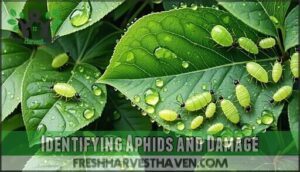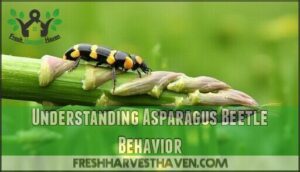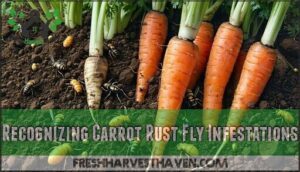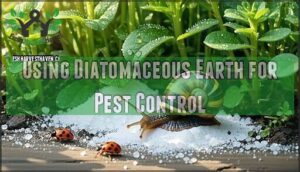This site is supported by our readers. We may earn a commission, at no cost to you, if you purchase through links.
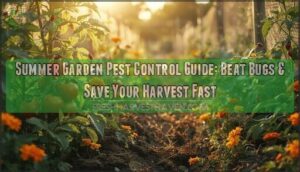
Your summer garden pest control guide starts with identifying common culprits: aphids clustering on tender shoots, Colorado potato beetles devouring spud plants, and cabbage worms munching through brassicas.
Combat these invaders using organic methods like physical barriers, beneficial insect habitats, and companion planting strategies.
Essential oils, soap sprays, and diatomaceous earth provide effective, chemical-free solutions.
Plant diversity confuses pests while attracting natural predators like ladybugs and lacewings.
Creating insectary areas with native flowering plants establishes a balanced ecosystem where beneficial insects thrive.
Strategic timing and targeted interventions can transform your garden from pest paradise to productive sanctuary.
Table Of Contents
- Key Takeaways
- Common Summer Pests
- Organic Pest Control
- Plant Diversity Strategies
- Attracting Beneficial Insects
- Natural Pest Management
- Frequently Asked Questions (FAQs)
- How do you get rid of garden pests?
- How do you get rid of pests in your home?
- Is Your House 100% pest-free?
- Can you use insecticide on a plant?
- Should you leave grass clippings on Your Lawn all summer?
- What is the best pest control for vegetable gardens?
- What are the three rules for pest control?
- Is there an app to identify garden pests?
- What is the best treatment for garden pests?
- What can I spray on my vegetable plants to keep bugs off?
- Conclusion
Key Takeaways
- Identify common pests early – You’ll catch aphids clustering on shoots, cabbage worms chewing through leaves, and Colorado potato beetles before they devastate your crops overnight.
- Use organic methods first – You can control most pests with physical barriers like row covers, beneficial insects like ladybugs, and natural sprays made from soap or essential oils.
- Create plant diversity – You’ll confuse pests and reduce infestations by mixing different crops together instead of growing single plants in rows, making it harder for bugs to find their targets.
- Attract beneficial insects – You can build a natural pest control army by planting native flowers like purple coneflower and yarrow that attract predatory insects to hunt down garden pests for you.
Common Summer Pests
You’ll encounter several destructive pests during summer that can quickly devastate your garden if left unchecked.
These common invaders target different plants and cause specific types of damage, so learning to identify them early gives you the best chance of protecting your harvest.
Identifying Aphids and Damage
Most aphid species cluster on tender shoots and leaf undersides, creating sticky honeydew that attracts ants and promotes sooty mold growth.
These tiny garden vampires leave behind a calling card that turns your plants into ant magnets.
You’ll spot these soft-bodied garden pests as green, black, or white clusters causing yellowed, curled leaves.
The honeydew effects include black fungal coating on plants, while ant mutualism protects aphids from predators, making summer pest identification essential for effective insect control.
Understanding Asparagus Beetle Behavior
When asparagus beetles emerge in spring, they’re like tiny armored tanks targeting your tender spears.
These blue-black garden pests with yellow markings complete their beetle life cycle through multiple generations each summer.
Adults and slug-like larvae show distinct feeding habits, creating visible scars on spears and ferns.
Understanding their larval behavior helps with damage prevention—they’re most vulnerable during early summer when asparagus vulnerability peaks, making timely pest control essential for protecting your harvest from these persistent vegetable pests.
Knowing how to identify common garden pests is vital for effective intervention, and recognizing the beetle life cycle and larval behavior can significantly enhance your ability to manage these pests, ultimately leading to a better harvest protection.
Cabbage Worms and Crop Impact
Within your vegetable garden, cabbage worms create holes in brassica leaves, stunting crop growth and reducing yields.
These green caterpillars turn your beautiful brassicas into Swiss cheese overnight.
These green caterpillars emerge from white butterfly eggs, progressing through multiple lifecycle stages before pupating. Cabbage worm ID involves spotting velvety green larvae with faint yellow stripes.
Organic solutions include Bt spray and row covers, while prevention methods focus on crop rotation and companion planting with aromatic herbs, which can help prevent cabbage worm issues.
Recognizing Carrot Rust Fly Infestations
Spotting these sneaky summer pests requires keen observation of your carrot crop’s health.
You’ll notice stunted growth and distorted roots with brown, rusty scars indicating larval identification within the roots.
Adult flies—shiny black with yellow heads—emerge during cool, wet spring weather, completing their fly life cycle in soil near host plants.
Root damage signs become evident at harvest when tunneling creates unmarketable carrots.
Conduct regular soil examination around plant bases for eggs, and implement preventative measures like crop rotation to disrupt this destructive pest’s breeding cycle, which can lead to significant root damage and require careful larval identification.
Managing Colorado Potato Beetles
Colorado potato beetles are relentless summer pests that can devastate entire potato crops in days.
Understanding their beetle life cycle helps you strike at vulnerable stages. Choose potato variety resistance cultivars when possible, as some varieties naturally repel these striped invaders.
Essential management strategies:
- Handpicking beetles and orange egg masses from leaf undersides during morning inspections
- Crop rotation away from nightshade family plants for at least two years
- Organic sprays like neem oil or spinosad targeting larvae before they mature
- Row covers during early season to prevent adult beetles from reaching plants
- Beneficial insects like ladybugs and parasitic wasps for natural pest control
Organic Pest Control
You don’t need harsh chemicals to protect your garden from summer pests when organic methods work just as well.
Physical barriers, natural sprays, and simple traps can keep bugs at bay while preserving the beneficial insects that help your plants thrive with natural sprays.
Using Physical Barriers to Deter Pests
Physical barriers create your first line of defense against hungry pests.
Row cover types like lightweight fabrics and copper mesh protect vulnerable plants without chemicals.
Mesh size matters—fine screens block tiny aphids while coarser materials stop larger beetles.
Plant collars around stems prevent cutworms from severing seedlings.
Maintain these pest management tools by checking for tears and securing edges properly for effective garden pest solutions.
You can also try interplanting techniques to further confuse pests, using methods like row cover and interplanting to protect your garden.
Applying Insect Netting and Row Covers
Row covers and insect netting provide excellent pest exclusion when properly installed over vulnerable crops.
Choose lightweight fabrics that allow adequate ventilation while blocking garden insects from reaching plants.
For netting installation, secure edges tightly to prevent pest entry points.
Different row cover types offer varying levels of crop protection – from fine mesh for aphids to heavier materials for larger pests.
Proper selection guarantees optimal garden protection via optimal garden protection.
Monitor ventilation needs regularly, as poor airflow can create humidity problems that attract different pest issues.
Ensure proper selection to achieve the desired level of protection for your garden.
Creating Beetle Banks and Traps
Beyond netting, you can build your own pest-fighting army with strategic beetle bank design and targeted traps.
These organic pest control methods create habitat manipulation that attracts beneficial insects while capturing harmful ones through smart trap crop selection and pitfall trap use.
- Beetle Bank Design: Create 1-2 meter wide raised strips using native grasses along garden edges
- Pitfall Trap Use: Sink containers into soil near pest hotspots for ground-dwelling insects
- Lure Development: Position traps strategically around vulnerable crops for maximum capture
- Habitat Manipulation: Combine banks with regular trap maintenance for sustained garden pest solutions
Using Diatomaceous Earth for Pest Control
While beetle banks trap crawling pests, diatomaceous earth creates a protective barrier that slices through soft-bodied insects’ exoskeletons. This Food Grade powder works best when applied during dry conditions for maximum Effectiveness Duration.
Sprinkle DE around plant bases targeting slugs and snails specifically. You can find products for slug control using diatomaceous earth.
Remember Safety Concerns – wear masks during application to avoid inhaling particles.
| Application Method | Target Pests |
|---|---|
| Ring around plants | Slugs, snails |
| Dust on leaves | Aphids, mites |
| Soil surface | Crawling insects |
| Storage areas | Grain beetles |
| Garden perimeter | Ant colonies |
Plant Diversity Strategies
You can outsmart garden pests by mixing different plants together instead of growing single crops in neat rows.
This polyculture approach confuses insects who rely on visual and chemical cues to find their favorite host plants, making your garden less appealing to destructive bugs.
While creating a more balanced ecosystem, this method ensures a healthier and more resilient garden environment.
Polyculture and Its Advantages in Pest Control
Polyculture-farming transforms your garden into a pest-resistant fortress by mimicking nature’s diversity.
This multi-crop approach creates increased biodiversity that naturally disrupts pest cycles, while reduced monoculture eliminates the "all-you-can-eat buffet" effect that attracts hungry insects to single-crop plantings.
- Natural pest resistance develops when diverse plants create chemical barriers and confusing scent trails
- Ecosystem stability improves as beneficial insects find varied food sources and shelter options
- Enhanced soil health results from different root systems and nutrient cycling patterns
- Pest prevention occurs through natural pesticides produced by companion plants like marigolds and basil
- Garden pest control becomes self-regulating as predator-prey relationships establish balance naturally
Interplanting for Pest Confusion and Reduction
When you mix different crops together, you’re basically throwing common garden pests off their game through scent masking and visual disruption.
This interplanting strategy creates resource dilution, making it harder for pests to locate their favorite plants.
Trap cropping works by placing pest-attracting plants away from your main crops, while habitat manipulation confuses pest navigation patterns, offering natural pest control without chemicals.
Companion Planting Strategies for Pest Management
Strategic companion planting creates natural pest control by leveraging plant relationships that confuse, repel, and redirect harmful insects.
You’ll maximize garden protection through these proven combinations:
- Basil near tomatoes – repelling specific pests like hornworms while attracting pollinators
- Marigolds with vegetables – providing camouflage planting that masks crop scents
- Nasturtiums as trap cropping – drawing aphids away from main crops
- Carrots with onions – creating nutrient synergy while deterring carrot flies
- Sage around brassicas – offering plant protection against cabbage moths
These pest control tips work because common garden pests rely on scent and visual cues.
Garden pest prevention becomes effortless when pest resistant plants work together naturally.
Avoiding Incompatible Plant Combinations
Smart gardening means knowing which plants don’t play well together. Plant antagonism occurs when certain crops release chemicals that inhibit neighboring plants’ growth or attract shared pests.
You’ll want to avoid these troublesome combinations to prevent pest damage and maintain healthy garden ecosystems.
| Avoid These Pairs | Why They Don’t Mix |
|---|---|
| Tomatoes + Corn | Both attract corn earworm, doubling pest damage |
| Onions + Beans | Allelopathic effects stunt bean growth |
| Cabbage + Strawberries | Compete for nutrients, attract similar pests |
| Carrots + Dill | Draw carrot rust flies to your garden |
Understanding these incompatible relationships helps you create pest resistant plants through better spacing and selection, reducing nutrient competition while protecting your harvest.
Employing companion planting strategies can further minimize these issues.
Attracting Beneficial Insects
You can transform your garden into a beneficial insect paradise by creating diverse flower-rich areas that provide natural pest control all season long.
Native plants like dill, fennel, and marigolds attract ladybugs, lacewings, and parasitic wasps that’ll hunt down aphids, caterpillars, and other destructive pests for you, utilizing natural pest control.
Creating Insectary Areas and Native Plant Gardens
Why not transform neglected garden corners into powerhouses of pest control? Creating insectary areas with native plants establishes permanent homes for beneficial insects while enhancing biodiversity.
These specialized zones provide year-round shelter, nectar sources, and overwintering sites for predatory insects that naturally control fruit pests. Strategic insectary design principles focus on selecting diverse native flowering plants that bloom throughout growing seasons, supporting organic gardening practices that reduce dependency on chemical interventions.
Healthy soil is key to plant pest resistance, which is crucial for maintaining a balanced ecosystem and ensuring the long-term health of your garden by promoting native plants and biodiversity.
Planting Native Flowering Plants for Beneficial Insects
Native plant selection creates powerful alliances in your garden’s war against fruit pests.
Choose species that bloom throughout summer, providing continuous nectar sources for beneficial insects. Local ecosystem support strengthens when you plant regionally adapted flowers that naturally attract pest predators. This sustainable pest control approach reduces chemical dependency while building pollinator diversity impact.
Here are five native flowering plants that transform your garden into a beneficial insect sanctuary:
- Purple Coneflower – Attracts parasitic wasps that demolish aphid colonies within days
- Black-eyed Susan – Draws hover flies whose larvae consume 500+ aphids each during development
- Wild Bergamot – Magnetizes predatory beetles that hunt cucumber beetles and squash bugs
- Yarrow – Supports tiny parasitic wasps that target caterpillars destroying your tomatoes
- Goldenrod – Hosts beneficial mites that devour spider mites threatening your bean plants
Design your insectary garden with overlapping bloom times, ensuring beneficial insects have consistent food sources. Plant clusters of each species rather than single specimens to maximize visual appeal for both insects and gardeners. Position these native plants near vegetable beds where pest control is most needed.
Avoiding Pesticides and Preserving Beneficial Insects
Chemical pesticides destroy your garden’s ecosystem balance by killing natural predators alongside pests.
You’ll break the cycle that keeps harmful insects in check. Skip broad-spectrum chemicals and embrace targeted solutions instead.
Your beneficial habitats depend on ladybugs, lacewings, and parasitic wasps surviving to provide organic pest management.
This integrated approach protects ecofriendly solutions while maintaining effective garden pest control through natural pest prevention methods.
Installing Bat Boxes for Natural Pest Control
During summer evenings, bats emerge as nature’s pest control squadron, devouring up to 1,000 insects per hour.
Installing bat boxes transforms your garden into a natural pest control powerhouse that works while you sleep.
Bat Box Placement and Setup Tips:
- Mount boxes 12-20 feet high facing south or southeast for ideal warmth and Bat Species Attracted success
- Position near water sources and insect-rich areas to maximize natural pest control effectiveness for summer garden protection
- Install multiple boxes to support larger colonies and enhance garden pest control capabilities
- Use untreated wood construction with rough interior surfaces for comfortable bat roosting and proper Box Maintenance Tips
- Check Local Regulations and join Community Bat Programs for expert guidance on bugs management strategies
Natural Pest Management
You can create powerful, natural pest deterrents using common household ingredients that target specific garden invaders without harming beneficial insects.
These eco-friendly solutions work by disrupting pest behavior and creating an environment that supports your garden’s natural defense system, using eco-friendly solutions and natural pest deterrents.
Using Essential Oils for Pest Control and Prevention
Your garden’s essential oil arsenal can tackle summer pests naturally and effectively.
Peppermint, neem, and eucalyptus oils disrupt insect nervous systems when properly diluted with water or carrier oils.
Studies show these organic gardening solutions reduce pest populations by up to 70%.
Apply via spray bottles, targeting aphids, spider mites, and beetles while preserving beneficial insects through careful concentration control, using essential oil and carrier oils.
Soap Solution Sprays for Pest Management and Control
Mix 2 tablespoons mild liquid soap with 1 quart water for effective pest control sprays.
This soap concentration targets soft-bodied insects like aphids without harming beneficial predators.
Test spray application on small plant areas first, checking plant sensitivity after 24 hours.
Adjust pest specificity by adding horticultural oils.
These natural remedies offer minimal environmental impact, making them ideal for organic gardening and sustainable summer garden care methods.
Garlic and Hot Pepper Sprays for Natural Pest Control
Determination becomes your greatest weapon when pests threaten your crops.
Create powerful garlic spray by blending three cloves with hot peppers and water, then straining the mixture. This natural arsenal repels aphids, spider mites, and soft-bodied insects effectively.
Apply during cool morning hours to prevent leaf burn, ensuring thorough coverage on leaf undersides. These homemade solutions offer safe, chemical-free protection.
For those seeking alternatives, consider garlic pepper spray products for convenience.
Maintaining a Balanced Ecosystem for Pest Prevention
Nature creates its own security system through Ecosystem Balance, where Natural Predators keep pest populations in check.
You’ll strengthen this system by maintaining Soil Health through compost and organic matter, which supports Biodiversity Importance.
Diverse plantings create Pest Resilience, reducing dependency on chemical interventions.
This natural pest management approach guarantees sustainable garden health through seasonal pest control methods.
Frequently Asked Questions (FAQs)
How do you get rid of garden pests?
Spider mites alone can destroy 80% of your plant’s leaves in just one week. You’ll win this battle using neem oil, insecticidal soap, and beneficial insects like ladybugs.
How do you get rid of pests in your home?
Keep homes pest-free by sealing entry points, removing food sources, and maintaining cleanliness.
Use targeted treatments like baits, traps, or sprays for specific pests.
Regular vacuuming and proper storage prevent infestations effectively.
Is Your House 100% pest-free?
You might think your house is a fortress, but pests are clever gatecrashers.
Even with strict cleaning and barriers, it’s nearly impossible to guarantee a 100% pest-free home—nature always finds a tiny crack to exploit.
Can you use insecticide on a plant?
Yes, you can safely use insecticides on plants when applied correctly.
Choose targeted options like insecticidal soap or neem oil rather than broad-spectrum chemicals that harm beneficial insects.
Always follow label instructions for proper application timing and dosage.
Should you leave grass clippings on Your Lawn all summer?
Picture emerald blades carpeting your yard like nature’s own recycling system.
You should leave grass clippings on your lawn all summer—they’ll decompose quickly, feeding nutrients back into the soil while saving you time and effort, acting like a natural recycling system.
What is the best pest control for vegetable gardens?
Floating row covers, beneficial insects, and neem oil form your garden’s defense trio.
You’ll control aphids, hornworms, and spider mites effectively while protecting crops.
Combine physical barriers with natural predators for thorough pest management success.
What are the three rules for pest control?
Prevention, persistence, and precision form pest control’s powerful trio.
You’ll prevent infestations through crop rotation and healthy soil, persist with regular monitoring and beneficial insect attraction, then precisely target specific pests using appropriate methods, which involves persistence.
Is there an app to identify garden pests?
Several smartphone apps can accurately identify garden pests using AI technology.
Popular options include Picture Insect, which uses AI to identify insects from photos, and Smart Identifier for plants and insects.
Simply snap a photo for instant identification.
The app boasts AI photo recognition of over 4,000 species.
What is the best treatment for garden pests?
Coincidentally, combining natural and chemical controls works best. Use beneficial insects like ladybugs for aphids, neem oil for spider mites, handpicking for hornworms, and row covers for prevention.
What can I spray on my vegetable plants to keep bugs off?
You can spray neem oil, insecticidal soap, or diatomaceous earth on your vegetable plants to effectively control bugs.
These natural treatments target soft-bodied insects like aphids and spider mites without harming beneficial insects or your crops when applied properly, using methods like insecticidal soap.
Conclusion
Last season, gardener Maria transformed her beetle-ravaged potato patch into a thriving ecosystem by introducing beneficial insects and companion plants, harvesting 40% more potatoes than previous years.
Effective summer garden pest control guide implementation requires consistent monitoring and integrated approaches.
You’ll achieve best results by combining physical barriers, beneficial insect habitats, and targeted organic treatments. Remember that healthy soil supports stronger plants naturally resistant to pest damage.
Start implementing these strategies early in the season for maximum protection and harvest success.

